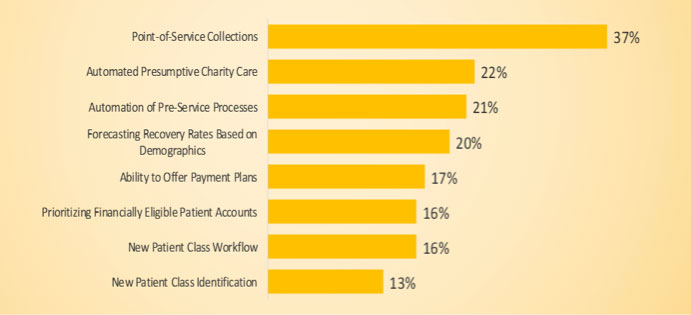March 6, 2018
Make Pre-Service Self-Pay Automation a 2018 Priority

Insurance companies may be the larger financial contributor to payment of insured service delivery, but hospitals are acutely aware that patient responsibility is a growing portion of all health service billing. The rise of high-deductible health plans is driving patients’ out-of-pocket costs skyward. According to research from the University of Michigan, out-of-pocket hospital care costs rose nearly 40 percent from 2009 to 2013 — a trend that continues.
Driven by an 86 percent rise in deductibles and a 33 percent increase in coinsurance, the portion of the hospital bill that patients are expected to pay rose faster than health insurance premiums, leaving patients with unexpected, confusing and unpaid bills.
Rising costs are driving patients to ignore or postpone service bills that they didn’t expect or don’t understand, creating revenue gaps for healthcare delivery organizations.
Patient Cost Estimation Takes Center Stage in the Revenue Cycle Conversation
Proactive patient communication is an engagement strategy that healthcare organizations are employing to optimize their revenue cycle and close payment gaps. While a greater number of care delivery organizations are turning their attention toward pre-service patient engagement, most healthcare teams rate current efforts as below average.
In a survey of senior healthcare finance executives and revenue cycle leaders, researchers at the Healthcare Financial Management Association explore self-pay processes and patient financial engagement efforts. This research confirms that organizations gain payment ground when they set financial expectations early in the patient outreach cycle. Full-circle communication and pricing transparency are proving to be the foundations of a strong revenue cycle.
How Do Healthcare Organizations Stack Up?
Patient engagement priorities shift the conversation about pricing and bill payment to pre-service and point-of-service touchpoints. The HFMA study finds that organizations rate pre-service pricing as their highest priority when considering how to engage patients in paying for their healthcare.
While patient communication programs are on the rise, only one in three hospitals has mandatory pre- or point-of-service collections processes in place for outpatient services. This leaves 68 percent of hospitals searching for more effective communication and payment solutions.
Financial Communication Priorities: Early, Often and Automated
Patients want responsive, convenient and transparent service payment options. An Accenture study focused on healthcare consumer engagement confirms the correlation between the customer service experience, financial experience and patient loyalty. Their study found that 47 percent of patients would switch healthcare providers for the ability to understand costs up front. This underscores HFMA’s recommendations that healthcare teams place a priority on pre-service financial education and collection.
Healthcare Teams Turn to Automation Solutions
Technology solutions delivering automated patient outreach and education help healthcare teams segment and tailor billing education to each consumer’s willingness and ability to pay. HFMA research notes that 74 percent of patients are willing and able to pay out-of-pocket expenses up to $1,000 per year — but poorly designed and delivered billing communication surprises six in 10 patients with unexpected, inconsistent or unclear healthcare bills.
 Caption: HFMA respondents indicate point-of-service collections and automation are the highest priorities when considering which self-pay processes to implement. Source: HFMA
Caption: HFMA respondents indicate point-of-service collections and automation are the highest priorities when considering which self-pay processes to implement. Source: HFMA
Our blog post, “Three Ways Healthcare Organizations Improve Self-Pay Processes,” explores specific actions healthcare organizations can take today to close self-pay revenue workflow gaps.
RevSpring Can Help
Integrated payment communication is part of RevSpring’s DNA. We tailor the payment conversation to influence behavior and inspire action. Our segmentation rules and workflows help you become hyper-focused on the patient and their unique payment pathways.
If you’d like to learn more about our comprehensive patient engagement and billing solutions, we’d love to help you. Request a demo to see how we can help your organization meet your goals.